Lawson M.V. Finite Automata
Подождите немного. Документ загружается.

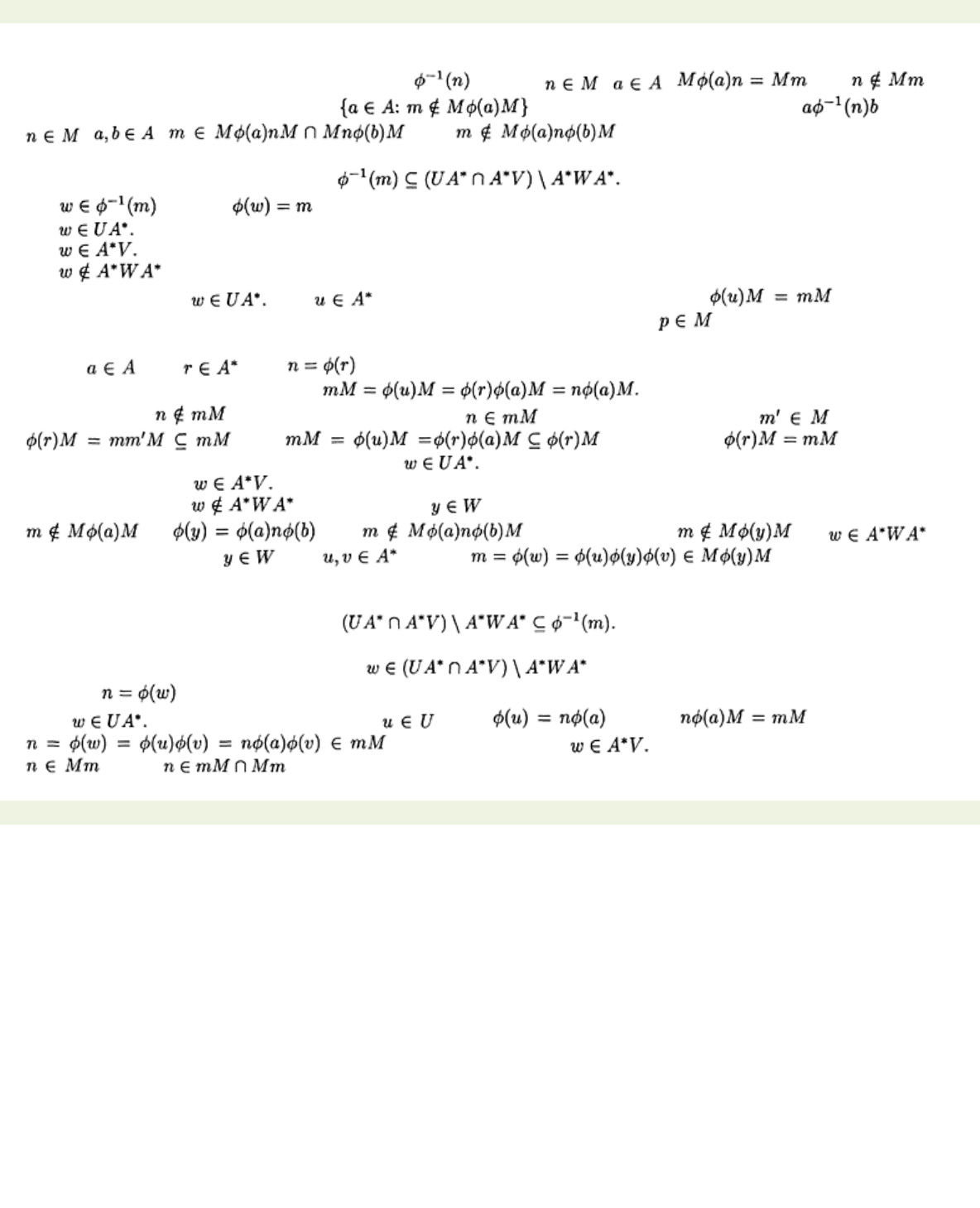
< previous page page_257 next page >
Page 257
•
The set V is the union of sets of the form , where , ,
but
.
•
The set W is the union of the set
together with sets of the form
, where
, ,
, but
.
Proof We prove first that
Let
so that . We have to show that
(1) .
(2)
.
(3) .
(1) We prove that . Let be the shortest prefix of
w
such that . We claim
that
u
≠
ε:
for if it were, we would have
mM
=
M
and so
mp=
1 for some which, by the cancellation
property for aperiodic monoids, would give
m
=1. Thus
u
≠
ε
as claimed. We can therefore write
u
=
ra,
where and . Put . Then
We claim that
:
for suppose we did have . Then
n
=
mm′
for some . Thus
,
and
,
which gives
,
which
contradicts our choice of
u
. It follows that , as claimed.
(2) The proof that
is similar to the above proof.
(3) We prove that . Suppose that . Then there are two possibilities. Either
y
=
a
and
or and . In either case, . If
then
w
=
uyv
for some and and so
,
which is a
contradiction.
We now have to prove the reverse inclusion:
Let
and put . We shall prove that
n
=
m
by using Proposition 11.4.5.
Now implies that
w
=
uv
where . Thus , where . Thus
. From the fact that
,
we may similarly show that
. Thus .
< previous page page_257 next page >

< previous page page_258 next page >
Page 258
It remains to be proved that
. So to this end suppose to the contrary that . This
means that
. Let
z
be a factor of
w,
so that
w
=
uzv,
of smallest possible length such that
. Clearly
z
≠
ε
since . Suppose that . By assumption and
so
,
which implies that
,
a contradiction. It follows that
z
has length at least 2.
Accordingly we can write
z
=
arb,
where and . Then since
z
was chosen
with minimum length. Similarly . It follows that
,
which is a contradiction. Hence
and we have proved the result.
We have now done most of the work needed to prove the hard direction of our main theorem.
Theorem 11.4.10
Let L be a recognisable language whose syntactic monoid M(L) is aperiodic. Then L
is star-free.
Proof Let be the natural monoid homomorphism and let
P
be the subset of
M(L)
such
that
. We can write
and so to prove that
L
is star-free it is enough to prove that each is star-free. If
m
=1, then this
is proved by Lemma 11.4.7. Suppose that for all
such that r
(n)
>r
(m)
we have proved that
is star-free. The fact that is star-free now follows from Proposition 11.4.9 and Lemma 11.4.8.
Combining Theorems 11.4.1 and 11.4.10, we obtain the following.
Theorem 11.4.11 (Schützenberger)
A recognisable language is star-free if and only if its syntactic
monoid is aperiodic.
Exercises 11.4
1. Show that the syntactic monoids of the basic languages are aperiodic.
2. Let
M
be a finite monoid and let . Prove that the containing the element
a
is equal to
11.5 An example
The goal of this section is to prove that the language
L
=(
ab
+
ba
)* is star-free and to find a star-free
generalised regular expression that describes it.
< previous page page_258 next page >
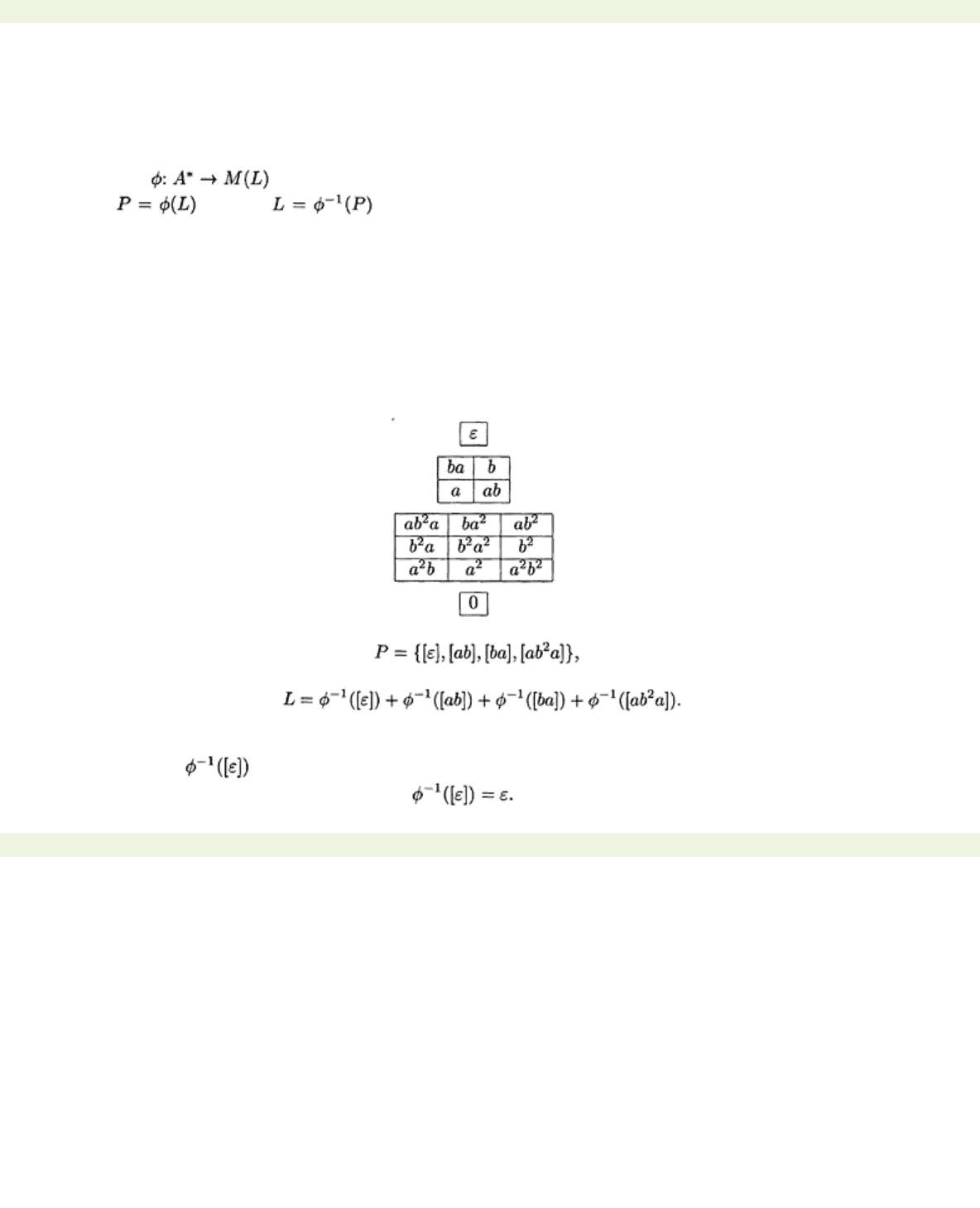
< previous page page_259 next page >
Page 259
In Example 9.4.5, we calculated a presentation of the syntactic monoid
M
=
M(L)
of
L,
using the minimal
automaton recognising
L
. From the table of representatives, we see that none of them induces a non-
trivial permutation on a subset of {0, 1, 2, 3}. Thus
L
is star-free. We wish to determine a star-free
expression for
L,
and this involves more work. Before dealing with this specific case, let me describe the
method we shall use. Let
L
be a recognisable language over the alphabet
A
whose syntactic monoid is
aperiodic. Let be the natural homomorphism corresponding to the syntactic congruence of
L,
and let so that by Lemma 10.2.4. The proof of Theorem 11.4.10 tells us that
we should first write
L
as the union of the inverse images of the elements
m
of
P,
since to find a star-
free expression for
L,
it is enough to find star-free expressions for each of these inverse images. The
proof of Theorem 11.4.10 depends on ordering the elements of
P
in such a way that the corresponding
list of ranks is non-increasing. For each element
m
in
P,
in the order described above, we shall apply
Proposition 11.4.9; this involves computing the sets
U, V
and
W
. For each of these sets we need to find
the
n
that satisfy the given conditions. By Lemma 11.4.8 we know that r
(n)
>r
(m)
. Of course,
n
must
satisfy other conditions, but the rank condition limits our choice and therefore the amount of work we
have to do. The other conditions that
n
must satisfy involve Green’s relations. It is clear, therefore, that
our first step in finding a star-free expression for our given
L
should be the computation of the egg-box
diagram of
M(L)
. Here is the egg-box diagram of
M(L)
where
L
=(
ab
+
ba
)*:
Denote the
σL
-class containing
x
by
[x]
. We have that
where I have listed the elements in non-increasing rank order. Thus
To find a star-free expression for
L,
it is enough to find a star-free expression for each of these four
languages.
(1)
The language .
This can be calculated using Lemma 11.4.7. We easily find in this case that
< previous page page_259 next page >
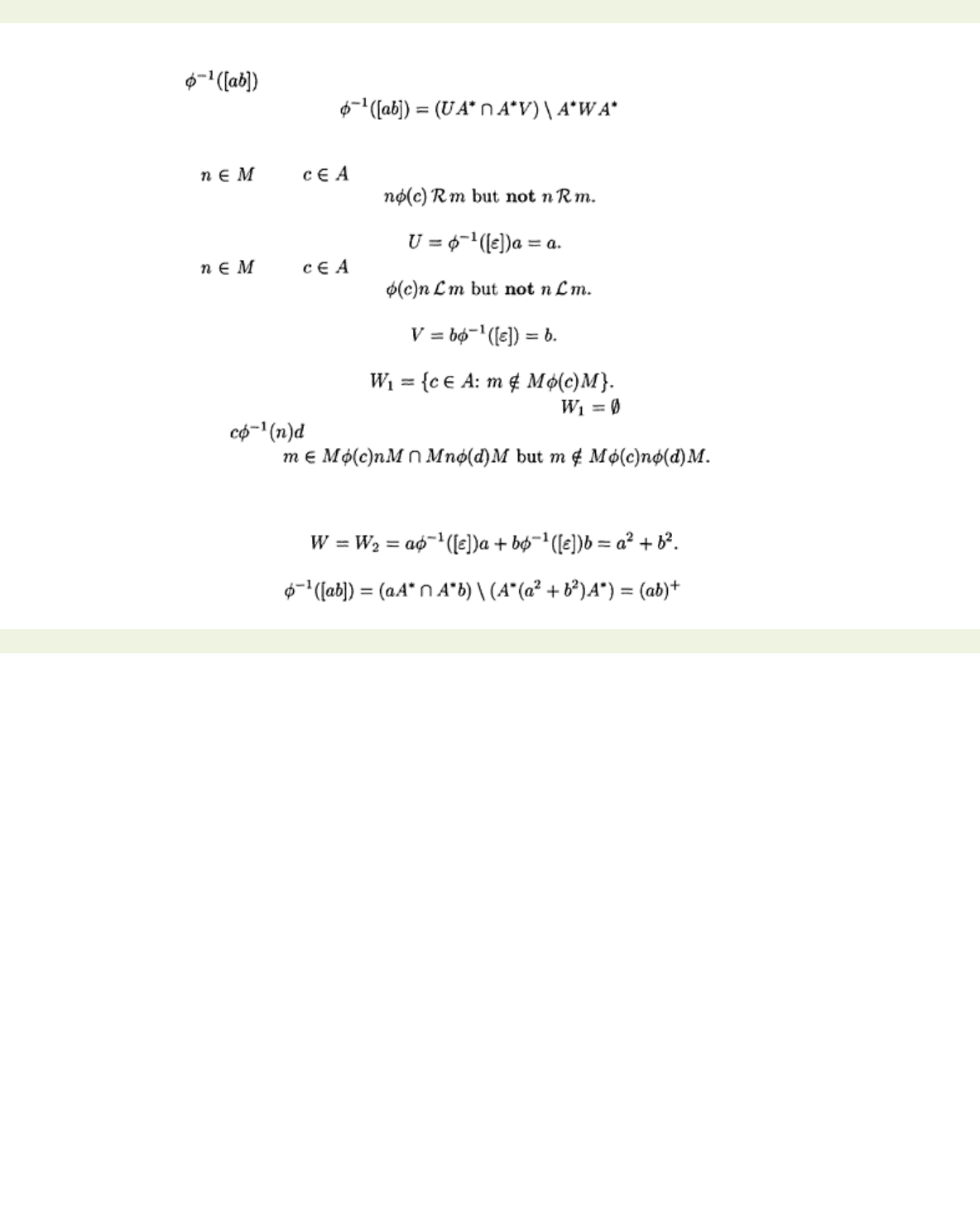
< previous page page_260 next page >
Page 260
(2)
The language .
We use Proposition 11.4.9. We know that we can write
Thus we have to calculate
U, V,
and
W
. It is here that we have to use the egg-box diagram. We shall
use
c
and
d
to denote elements of
A
to avoid confusion. Put
m
=
[ab]
.
U:
We need to find and such that
Also r
(n)
>r
(m)
. The only possibility for n is therefore
n
=
[ε]
. Thus
c
=
a
. It follows that
V:
We need to find and such that
Once again r
(n)
>r
(m)
. The only possibility for
n
is therefore
n
=
[ε]
. Thus
c
=
b
. It follows that
W:
This breaks down into two parts, which I shall call
W
1 and
W
2, respectively. First we calculate
Now both
M[a]M
and
M[b]M
contain
[ab]
. It follows that . We now turn to
W
2. This involves
looking for the sets
, where
Again r
(n)
>r
(m)
. The only possibility for
n
is
n
=
[ε]
. We now need to find the values of
c
and
d
so
that the triple
(c, [ε], d)
satisfies the conditions above. There are four cases to check, and we quickly
find that the only possible values of
(c, n, d)
are:
(a, [ε], a)
and
(b, [ε], b)
. Thus
Putting all these calculations together we obtain
< previous page page_260 next page >
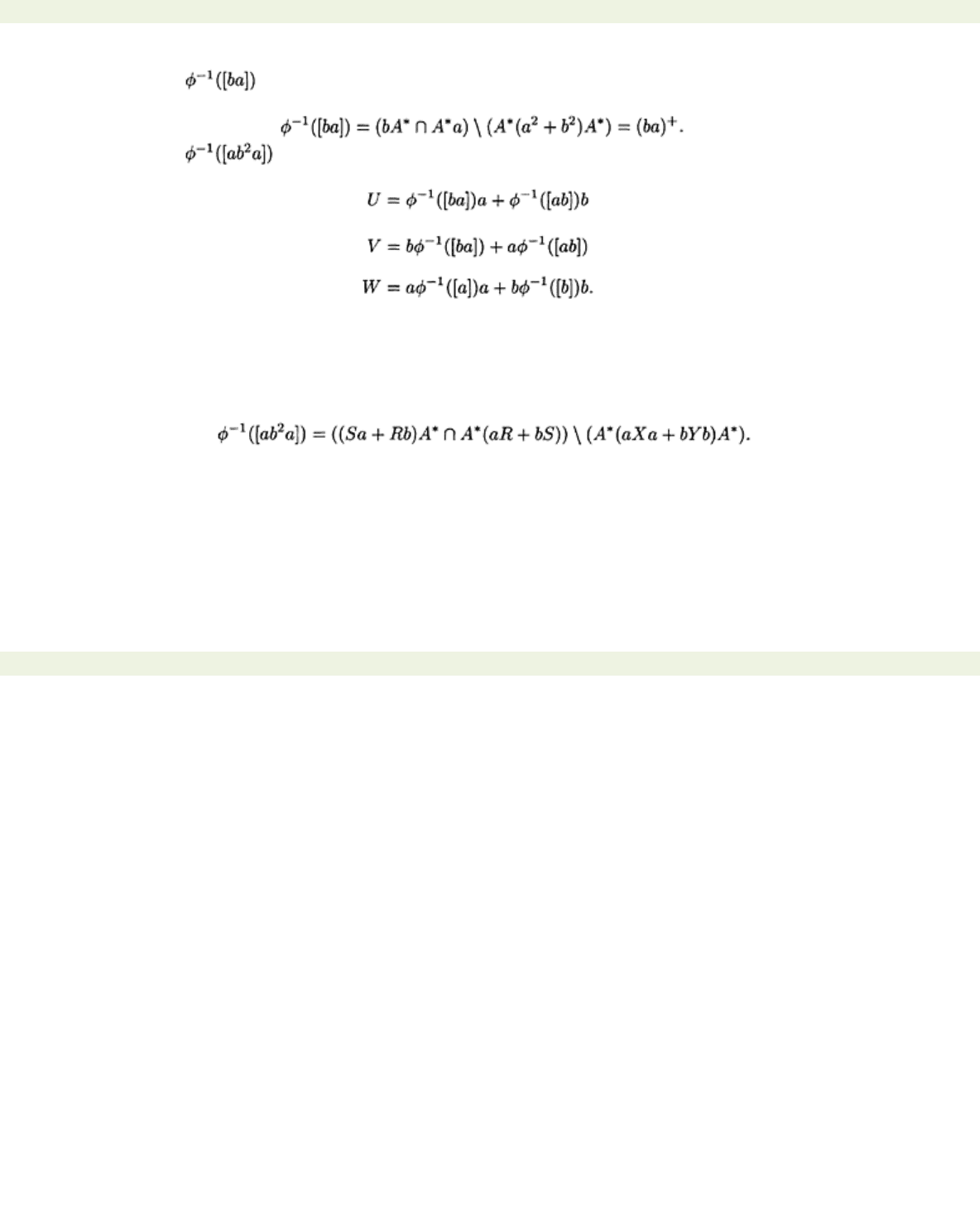
< previous page page_261 next page >
Page 261
(3)
The language .
The calculations for this case are similar to the calculations in (2) above with
the roles of
a
and
b
interchanged. Thus
(4)
The language .
Once again we have to calculate the sets
U, V,
and
W
. I shall leave it as
an exercise for you to check the following:
Make the following definitions:
•
R
=
(ab)
+.
•
S
=
(ba)
+.
•
X
=
a(ba)
*.
•
Y
=
b(ab)
*.
Then
U
=
Sa
+
Rb, V
=
aR
+
bS,
and
W
=
aXa
+
bYb
. Thus
11.6 Summary of Chapter 11
•
Star-free languages:
A language is star-free if it can be constructed from finite languages using the
Boolean operations and product but not Kleene star.
•
Groups:
A group is a monoid in which each element has an inverse. A group with exactly one element
is said to be trivial. A group in a semigroup is simply a subsemigroup that is also a group.
•
Aperiodic monoids:
A monoid is aperiodic if the only groups in the monoid are trivial. A submonoid of
an aperiodic monoid is aperiodic, a homomorphic image of an aperiodic monoid is aperiodic, products of
aperiodic monoids are aperiodic, and Schützenberger products of aperiodic monoids are aperiodic.
•
Schützenberger’s Theorem:
A language is star-free if and only if its syntactic monoid is aperiodic.
< previous page page_261 next page >
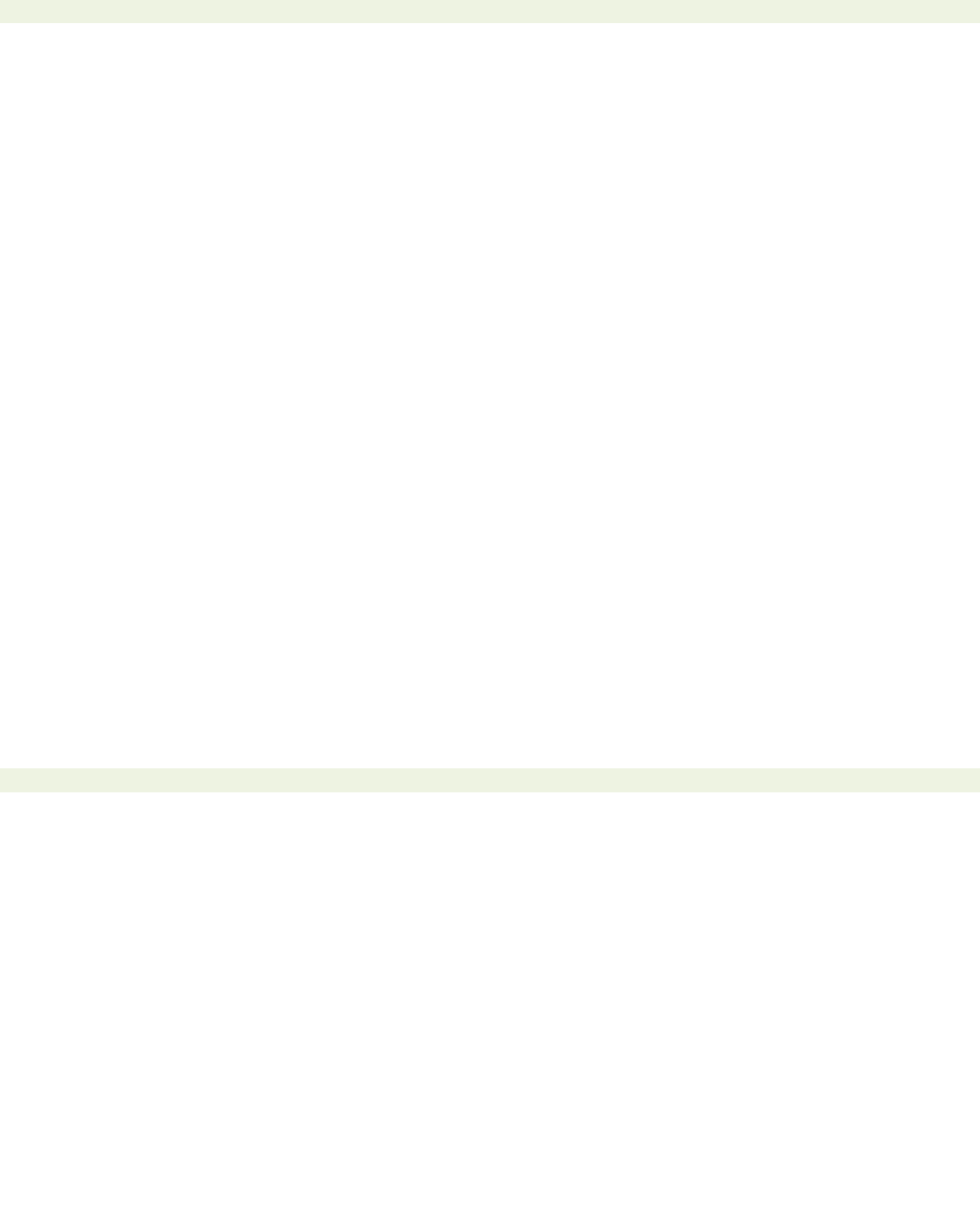
< previous page page_262 next page >
Page 262
11.7 Remarks on Chapter 11
The class of star-free languages seems to have first been studied by Trakhtenbrot in 1958 and
McNaughton in 1960. Schützenberger’s Theorem was first proved in [116]. The book by McNaughton
and Papert [88] gives a fascinating account of the many different, but equivalent, ways that the class of
star-free languages can be characterised. These results lead one to surmise that the class of star-free
languages is a natural one. The proof I give of Schützenberger’s Theorem is due to Perrin [100]. A short
proof can be found in [62]. The proof of Proposition 11.2.15 is adapted from [54].
There is an alternative proof of Schützenberger’s Theorem that uses completely different ideas. In
Section 1.7, I defined what is meant by a ‘semiautomaton.’ This notion underlies both finite automata in
the sense of this book and the automata with output such as the Moore and Mealy machines also
introduced in Section 1.7. Much of automata theory can be developed as the theory of semiautomata
and then adapted to deal with acceptors or automata with output. This was the approach adopted by
John Rhodes in his early work and developed with the help of colleagues and students at Berkeley. The
key theorem of the Rhodes School is the Krohn-Rhodes Theorem, which I shall briefly sketch. By using
output functions in the sense of Moore machines, it is possible to connect semiautomata in series so
that the output of one machine becomes the input of the next. Such a combination of semiautomata is
called a ‘cascade product’ and is itself a semiautomaton. We now single out two classes of
semiautomata. A
reset semiautomaton
has the property that the effect of each input letter is to act
either as the identity function on the set of states, or as a constant function. A
grouplike semiautomaton
has as the set of states a group
G,
input alphabet
G,
and the action of an input letter is by right
multiplication. A group
G
is said to be
simple
if the only normal subgroups are the trivial subgroup and
G
itself; normal subgroups were defined in Question 11 of Exercises 11.2. A
simple grouplike
semiautomaton
is a grouplike semiautomaton in which the group involved is simple. Finally, we say that
the semiautomaton A
covers
the semiautomaton B if B is a homomorphic image of a subsemiautomaton
of A; I shall not define this more precisely here. We can now state the Krohn-Rhodes Theorem [76]:
every semiautomaton A can be covered by a cascade product of semiautomata each of which is either a
two-state reset semiautomaton or a simple grouplike semiautomaton. Furthermore, the groups occurring
in the grouplike semiautomata divide the groups in the transition monoid of A. A proof of this theorem is
described in [54]. The Krohn-Rhodes Theorem can be used to prove the hard direction of
Schützenberger’s Theorem: if a recognisable language
L
has an aperiodic syntactic monoid then
L
is
star-free. The proof runs as follows. Let A be the minimal automaton for
L
. Then the transition monoid
of A is isomorphic to the syntactic monoid of
L
and so is aperiodic. The Krohn-Rhodes Theorem applies
to the semiautomaton underlying A. Because the transition monoid is aperiodic, we conclude that the
semiautomaton underlying A can be covered
< previous page page_262 next page >
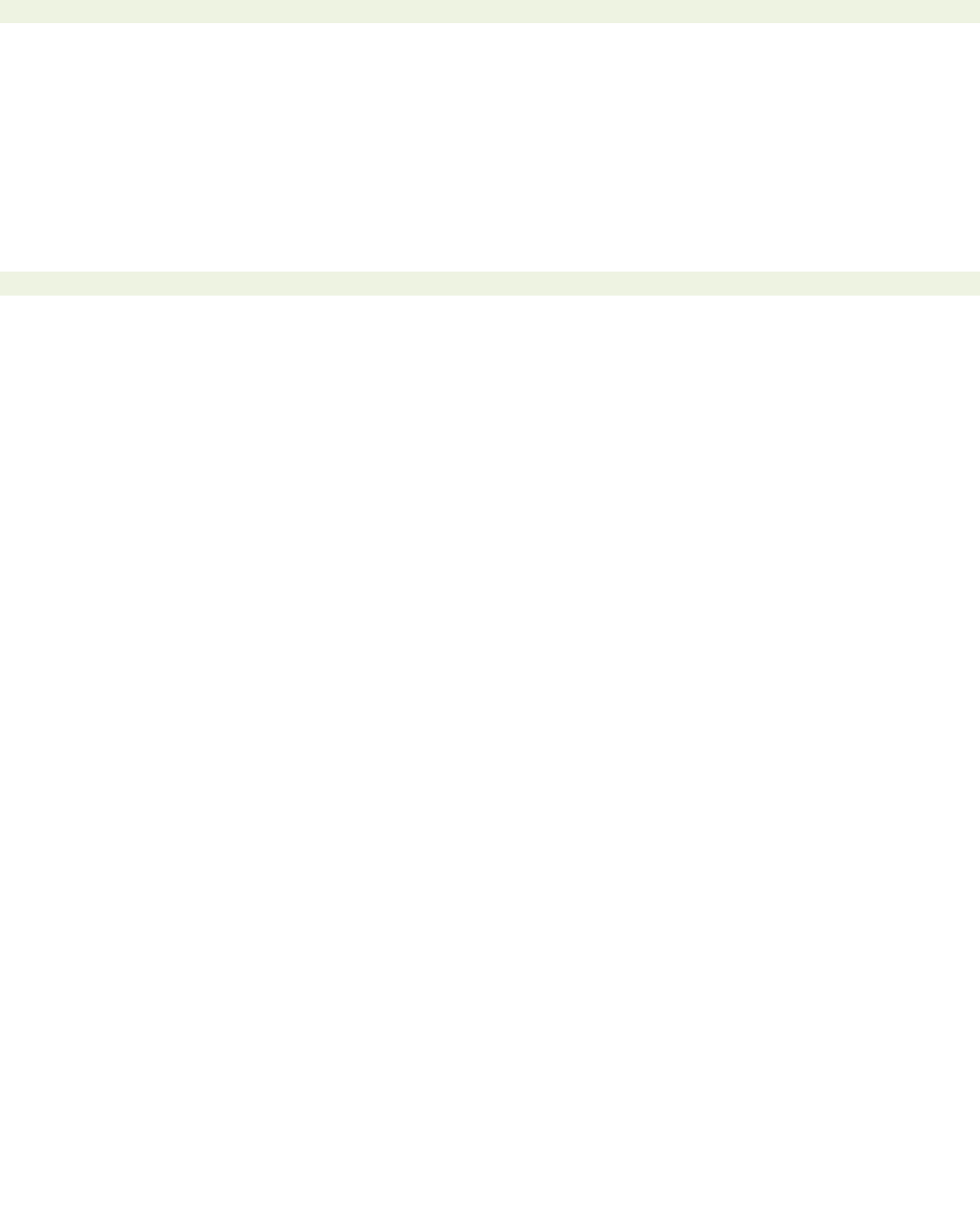
< previous page page_263 next page >
Page 263
by a cascade product of two-state reset semiautomata, i.e., because of aperiodicity no groups are
involved. It is then reasonably easy to prove that
L
can be accepted by an automaton whose underlying
semiautomaton is itself a cascade product of two-state reset semiautomata. The proof that
L
is star-free
can now be completed by induction on the number of reset semiautomata involved in the cascade
representation. The proof of this can be found in [54]. The Krohn-Rhodes Theorem is important in the
study of sequential functions. I shall say a little more about this topic in the Remarks on Chapter 12.
Despite their lack of idempotents, groups are quite interesting. An introductory account can be found in
[46]. A more advanced work is Stewart [127], who explains how groups were first introduced as a tool
for studying algebraic equations.
< previous page page_263 next page >

< previous page page_264 next page >
Page 264
This page intentionally left blank.
< previous page page_264 next page >
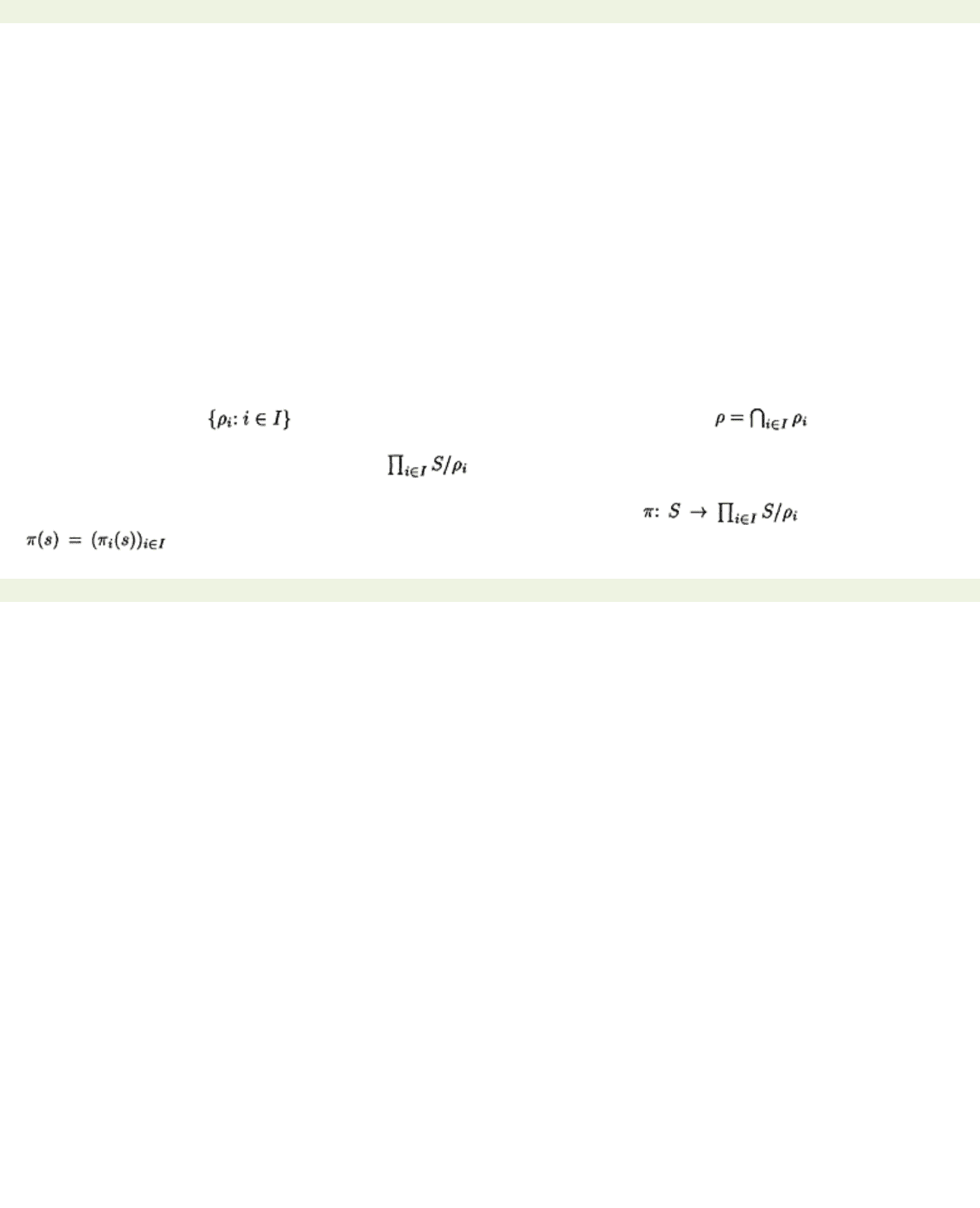
< previous page page_265 next page >
Page 265
Chapter 12
Varieties of languages
In Theorem 9.4.3, we proved that a language is recognisable precisely when its syntactic monoid is
finite. This result opened the door to an algebraic approach to recognisable languages. In Chapter 11,
we showed that the syntactic monoid is an important tool in studying recognisable languages when we
characterised star-free languages in terms of their syntactic monoids. However, we showed in Section
10.3 that not every finite monoid is a syntactic monoid, and that different languages can have the same
syntactic monoid. What these results point us toward is this: there is a correspondence, not between
individual
finite monoids and
individual
recognisable languages, but between
families
of monoids and
families
of languages. The aim of this chapter is to explain what this means and to prove the theorem
on which it depends: the Variety Theorem of Eilenberg and Schützenberger. This theorem provides a
framework for thinking about finite monoids and recognisable languages.
All monoids in this chapter are finite.
12.1 Pseudovarieties and varieties
Proposition 10.3.4 gave us examples of finite monoids that are not syntactic monoids. However, there is
a connection between arbitrary finite monoids and syntactic monoids. To see what this is, we first need
a lemma.
Lemma 12.1.1
Let
be a set of congruences on a semigroup S. Put
. Then:
(i)
ρ is a congruence on S.
(ii)
S/ρ is isomorphic to a subsemigroup .
Proof (i) This is left as an exercise.
(ii) Let
πi: S
→
S
/
ρi
be the natural homomorphism
πi(s)
=
ρi(s)
. Define by
. This is clearly a homomorphism.
< previous page page_265 next page >
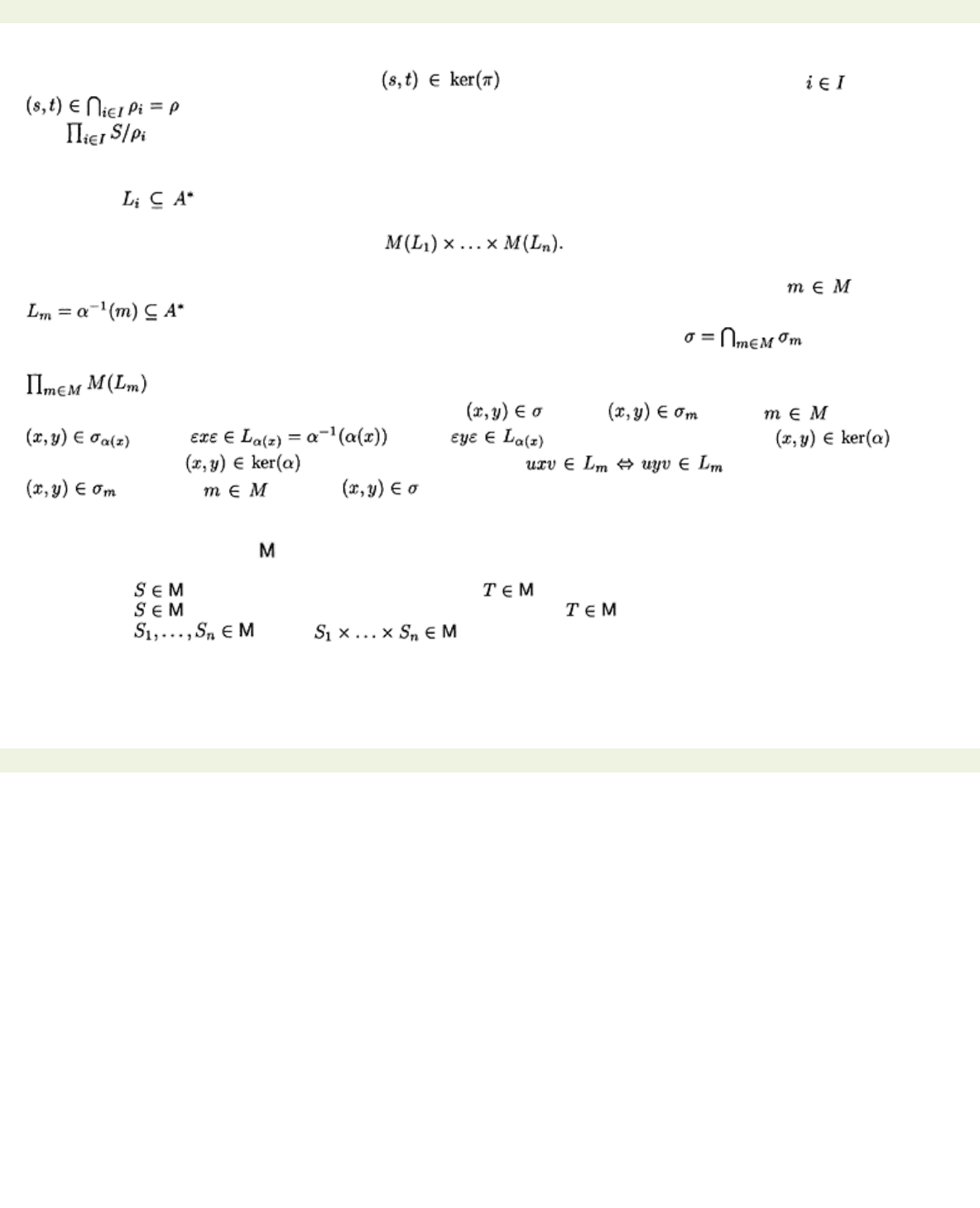
< previous page page_266 next page >
Page 266
We now calculate the kernel of
π
. Then iff
π(s)
=
π(t)
iff
πi(s)
=
πi(t)
for all iff
. Thus ker
(π)
=
ρ
. By Theorem 9.2.11, there is an injective homomorphism from
S
/
ρ
into .
Our next result assuages the disappointment of Proposition 10.3.4 and points us in the right direction.
Theorem 12.1.2
Let M be a finite monoid. Then there is a finite alphabet A and finitely many
languages
, where
1≤
i
≤
n, such that each language Li is recognised by M, and M is isomorphic
to a submonoid of
Proof Let
M
be a finite monoid, in particular
M
is finitely generated. Thus there exists a finite alphabet
A
and a surjective monoid homomorphism
α: A
*→
M
by Proposition 10.2.2. For each , define
, which, by construction, is a language recognised by
M
. Let
σm
be the syntactic
congruence of
Lm
. Then
A
*/
σm
=
M(Lm),
the syntactic monoid of
Lm
. Put
,
a congruence
by Lemma 12.1.1(1). By Lemma 12.1.1(ii), there is an injective homomorphism from
A
*/
σ
to
. To conclude the proof, we show that
σ
=ker
(α)
which, by Theorem 9.2.11, will prove that
A
*/
σ
is isomorphic to
M,
giving us the result. Let . Then for all . In particular,
. Now . Thus and so
α(y)
=
α(x),
giving as
required. Now let . It is easy to check that . It follows that
for each and so .
The theorem above highlights three operations: taking submonoids of monoids, taking homomorphic
images of monoids, and taking finite products of monoids. This leads us to the following definition. A
pseudovariety of monoids
is a non-empty collection of monoids satisfying the following three
conditions:
(VM1) If and
T
is a submonoid of
S,
then .
(VM2) If and
T
is a homomorphic image of
S,
then .
(VM3)
If
, then .
Examples 12.1.3 Here are some examples of pseudovarieties of monoids.
(1)
Finite monoids.
This is clear.
(2)
Finite aperiodic monoids.
We proved this in Theorem 11.3.4.
(3)
Finite commutative monoids.
This is left as an exercise.
< previous page page_266 next page >
